 |
Flavors of Cambodia > Street Food
Cambodian street food is the forgotten orphan of Southeast Asia. Cambodian street food is still an enigma, at least to those who’ve never walked and tasted the streets of Cambodia’s cities. Meanwhile, Thai fried noodles, Singaporean Hainanese chicken rice, and Vietnamese pho get lots of well-deserved recognition worldwide.
Even if you’ve had the chance to be a foodie in the Kingdom of Wonder, chances are that you’ve walked away disappointed. Authentic Cambodian food is not that easy to find if you’re a foreigner.
As a tourist, you’re more likely to see half-baked Cambodian attempts at Western dishes as you walk along a city street. Take stock of Phnom Penh’s myriad sandwich boards, and you’ll find all sorts of burgers, salads, nachos, burritos, happy pizzas, and other occidental concoctions. I’ve had a boiled potato with canned tuna at one of these tourist-focused restaurants, for instance; let’s just say it was a let down and leave it there. In light of this, you’ll wonder: Where’s the real Cambodian street food?
The reason behind the seemingly Western selection of fast food is simple: Cambodians genuinely believe that Khmer cuisine repels foreigners. You can’t blame them. I know few westerners who salivate upon smelling prahok, Cambodia’s famed fermented fish paste. Likewise, not many tourists stand in line for a helping of grilled pork intestines or roasted crickets. But Cambodian street food is so much more than these controversial delicacies — you just have to know where to find the good stuff. From Battambang to Kampot, city streets boast an eye-popping selection of mouth watering street food that should be palatable to the pickiest of diners. At night, you’ll find grilled beef sticks, papaya salad, barbecued chicken, and other iconic dishes. And in the morning, you’ll be greeted by a hot bowl of kuy teav or smoky pork and rice — the choice is yours.
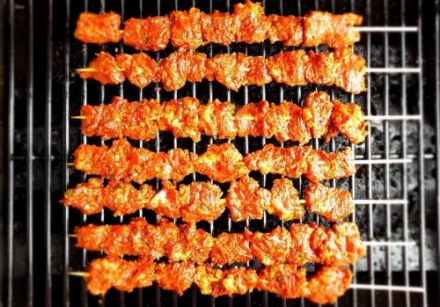
Grilled beef skewers top our list of Cambodian street food for a reason — they’re the quintessential dinner dish that you’ll find in every corner of Cambodia. Just as the sun starts to set, the nation’s charcoal grills come alive with the aromatic smoke and unmistakable sizzle of these tiny beef skewers. These beef sticks are immensely popular with locals for their unforgettable citrusy flavor; and, because they’re so affordable (4 skewers will set you back $1-$2, depending on where you are). And since they’re so popular, the street food hawks who sell beef skewers amass long lineups around the dinner hour and their precious product sells out fast. So, if you’re hoping to get your hands on grilled beef skewers while visiting the Kingdom of Wonder, don’t waste time and get down to the closest street food stall around 5pm.

Bai Sach Chrouk is one of two classic Cambodian breakfast dishes (Kuy Teav is the other). Meaning “rice pork” in English, bai sach chrouk is much more than it’s verbatim translation: it’s the aroma of Phnom Penh’s boulevards at sunrise; it’s Cambodia’s answer to bacon and eggs; it’s the reason Cambodians get out of bed in the morning. Served with a refreshing iced coffee or jasmine tea, bai sach chrouk offers diners a calorie-packed breakfast of grilled pork, steamed rice, pickled vegetables, and the classic Cambodian dipping sauce — teuk trei Koh Kong. Like all Cambodian street food that exists fleetingly during a certain meal hour, bai sach chrouk disappears from restaurants quickly — by about 8am, just after breakfast.
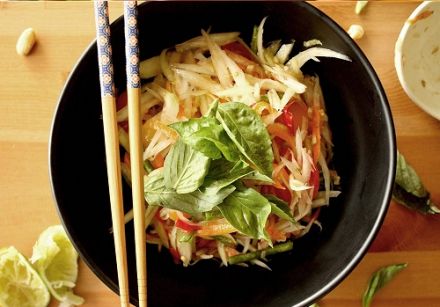
Green papaya salad is the archetypal street food dish in all Southeast Asian nations, including Cambodia. Bok Lahong, as papaya salad is known in the Kingdom, comes in all shapes and flavors in most of the nation’s cities and villages. Papaya salad with pickled crab? Check. One with shrimp paste instead? Done. A simple one with prahok? Of course. And the ingredients go far beyond the obvious. Apart from the unripe papaya shreds and your choice of protein, there’s the dressing. Oh, the dressing. Made with as many chillies as your mouth can handle, fish sauce, lime, and sugar, it’s a fiery, mouth-scorching affair that satisfies with intense, yet oddly refreshing flavors.
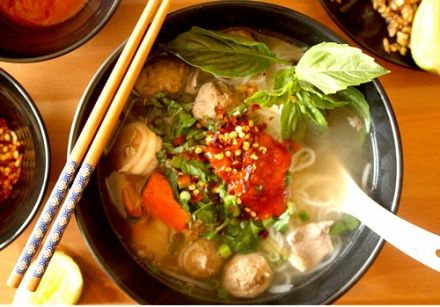
If you’ve ever wondered why people in Southeast Asia have soup for breakfast, go ahead and try a bowl of Kuy Teav at any Phnom Penh street food stall in the morning — you’ll have your answer.
Kuy Teav (also known as Phnom Penh noodles) is a traditional breakfast dish is the typical alternative to bai sach chrouk, and a favorite on the cooler days during the rainy season. Kuy Teav gets its name from the type of thin, flat noodles used in the soup. If you’re walking down a city street in the morning and spot large sooty cauldrons steaming away over a wood fire, chances are the stall sells kuy teav. In fact, the owner will likely have an assortment of noodles for you to choose from — glass noodles (mi suo), egg noodles, pin noodles (lot), can all be used in the kuy teav broth. To get the broth its opulent taste and aroma, the owner will have started boiling the pork bones in the wee hours of the morning, long before the first buzz of the motorbikes ushers in hordes of hungry diners.
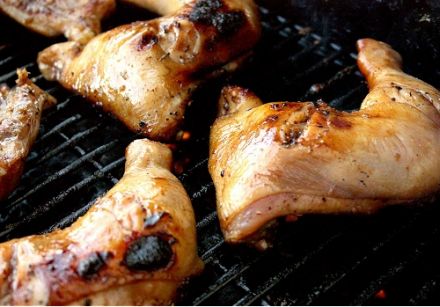
No Cambodian street food list is complete without barbecued chicken — and chicken legs in particular. There are a few things that make Cambodian barbecued chicken legs so special. First, the chicken is marinated in a mixture of honey, soy sauce, garlic, and crushed cilantro roots. This marinade gives the chicken a unique flavor that is both savory and slightly sweet, with earthy tones from the cilantro. Second, the chicken legs are cooked over an open flame, which is how they get their charred flavor. Finally, the grilled legs are served with a a zesty salad — papaya salad is an excellent choice — and the famous Koh Kong dipping sauce. (A cold beer is a must with these BBQ chicken legs, too.)
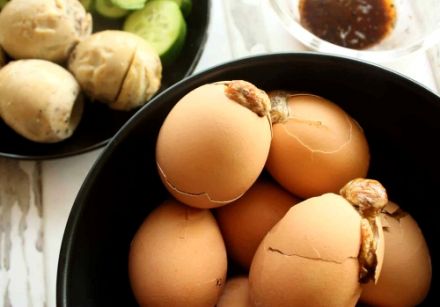
Wander through a Cambodian city for longer than an hour, and you’re bound to see a street food hawker selling grilled eggs from atop their motorike. You may not discern what the hawker’s loudspeaker is saying on repeat, but if you look right behind the rider, you’ll see a square crate with eggs secured to the back of the bike with bungee cords (or some other contraption). These are, in fact, grilled eggs. But they’re not grilled whole. These eggs are the fruits of a laborious process that sees their contents drained, mixed with various spices and condiments, then returned to the egg via a funnel, before getting steamed and finally barbecued. The result is an unexpected, delectable snack that’ll keep your taste buds happy and your belly full as you bar hop your way through the city. Likewise, at home, grilled eggs will be an unforgettable hors d’oeuvre the next time you entertain.
> If you’re ready to give this Cambodian street food snack a try, go ahead and check out her 30-minute grilled eggs recipe on Thida's Kitchen.

Thida Koeut, born near Kampot, Cambodia, is the chef and author behind Thida's Kitchen. Immersed in Cambodian gastronomy from childhood, she later managed a renowned Danish-French fusion restaurant in Kampot, mastering European culinary techniques. Her hands-on farming experience deepened her connection to authentic Cambodian ingredients.
Follow her on Thida's Kitchen to learn more about Cambodian food. She will guide you step by step through authentic recipes with the help of her husband Nick, food photographer.

-

 Recipes
Recipes
-

 Products
Products
-

 Entertaining
Entertaining
-

 Chefs
Chefs
-

 Hints & Tips
Hints & Tips
-

 Glossaries
Glossaries








